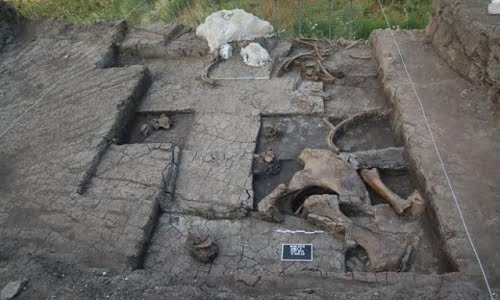A great prehistoric elephant had died in Megalopolis.
Some of his bones were only revealed in the morning. Already since antiquity in the region, other fossils of those distant seasons have been found, causing interesting confusions. That, let’s say, belonged to the Titans. So, in the “Great City” area, the famous epic Titanomachia (Battle of the Titans) was placed.
Sections of two tusks (1.80 m in length) and fragments from the same parts of the animal were the findings of the Ephorate of Prehistoric and Classical Antiquities of Arcadia. They were found during excavations for a PPC building and are kept in a protected area. Whether to be transferred or exposed will depend on the findings of the competent Ephorate of Palaeoanthropology – Speleology of Southern Greece, as told by the head of NAPE, Anna Karapanagiotou.
Mrs. Karapanagiotou notes that the excavations have been shifted to another site in order for the site to be examined by the competent archaeologist. The Palaeoanthropologist-Speleologist, Aikaterini Kyparissi-Apostolika, says in the “Ethnos” newspaper that an animal shoulder was found yesterday and that Athanasios Athanasiou, who rushed to the area as a specialist, examined the fragments of the tusks.
The basin of Megalopolis hundreds of thousands of years ago was a shallow lake with lush vegetation. When the waters found a way out to the sea, the lake dried up and the animals disappeared. From time to time, fossilized animal skeletons that gave rise to beautiful myths came to light.
The ancient traveler Pausanias writes that there is a sanctuary of Asklepios opposite the Megalopolis Agora. In it are found “and bones that outnumber the common human bones. That’s why it was the tradition that they belonged to one of the giants who brought them as allies of Rea the Opladamos. ”
If Pausanias saw the elephant shoulder that was discovered yesterday, he would again identify with the Titanic remnants. As scientists speculate after several studies, one of the bones that may have led the ancients to this glory was only the femur of a huge elephant that had disappeared since antiquity. It is also known as the “Nichoria’s Bone” and has been transferred to America, as well as to England, to study.
Adrien Mayor, a Stanford University Researcher of Classical and Historical Studies, notes: “This great bone is worth displaying to the public. It is one of the two unique huge vertebrate fossils found in antiquity and discovered by archaeologists in Greece. ” Indeed, in her book “Hunters of the First Fossils” (2000) he reports that fossils such as this may have been a source of inspiration for many legendary monsters of classical mythology.
In 1902
The fossils were accidentally identified in 1902 by a villager. At the same time, Professor Skoufos begins excavations. Five tons of fossilized skeletons are transferred to the Palaeontological Museum of the University of Athens.
The study of these fossils showed that two categories of mammals lived on the shores of Lake Megalopolis: Animals in warm climate and rich vegetation, elephants, deer, rhinoceros, hippopotamus, horses. Animals that are in cold climates and frozen may be areas of steppe and tundra vegetation, mammoths, bison, and hairy rhinos.
MEETING WITH THE PEOPLE ?
Is it possible to meet the prehistoric man with this particular elephant? This will be investigated by archaeologists, as yesterday’s findings were complemented by a Paleolithic tool, which should, above all, be dated to have an answer to the question.
www.enet.gr , http://filiatranet.gr/blog-post_7804-3/
Stone art next to elephant bones and other mammals, dating back to 300,000-600,000 years before today.
Fig. 1: Marathousa 1: Partial view of the site of the excavation with part of the elephant skeleton.
Fig 2: Marathousa 1: Stone tools.
According to the first excavation data, Palaeolithic people built on earth stone art, suitable for the skinning and slicing of the elephant. Traces of cutting from the stone tools were found in several of the elephant’s bones, which indicates that Marathousa 1 is a “slaughter place”.
Fig. 3: Marathousa 1: Elephant bone in stratigraphic affinity with a stone tool (in a circle).
Fig. 4: Marathousa 1: Microscope photograph, in which traces of cutting into elephant bone are visible.
Today, in the village of Isioma Karyon, located outside Megalopolis, the visitor can get a little taste of what was happening in the area, the Information Station and the Support Laboratory created by the National and Kapodistrian University with the support of the Megalopolis Association of people of the village Isioma Karyon in 2013. Here, you can see the work of the Research Group of the University of Athens, Prof. Georgiou Theodoros, who has conducted palaeontological excavations since 2009, educational programs for students in collaboration with the Municipality of Megalopoli, has given numerous lectures and more.
On Saturday, August 26, 2017 at 11 am, at a short distance from the village, next to the springs of Ai-Giannis Isioma of Karyes Megalopolis, was founded the first Palaeontological Museum and Natural History Park of the Peloponnese. “It is a project that belongs to the Municipality of Megalopolis and by extension to the Region of Peloponnese and is financed by them.
https://kafeneio-megalopolis.gr
www.eleftheriaonline.gr , www.kathimerini.gr , https://www.megalopoli.gov.gr


0 Comment